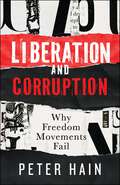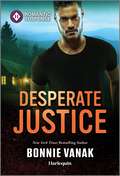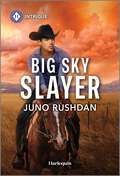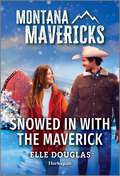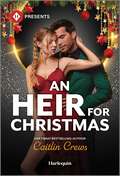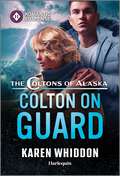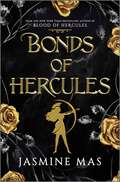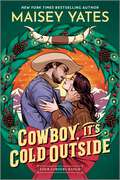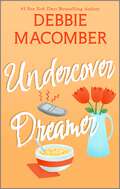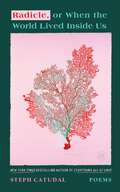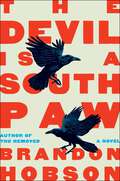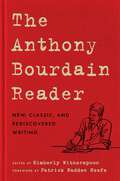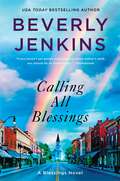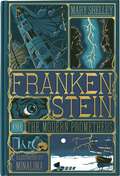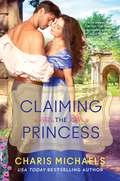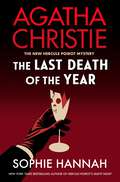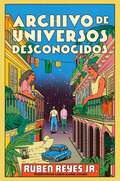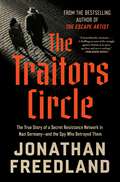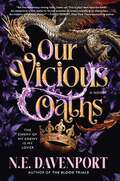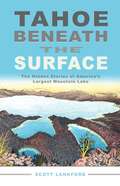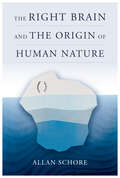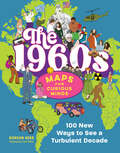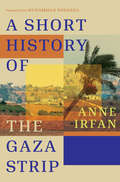- Table View
- List View
Liberation and Corruption: Why Freedom Movements Fail
by Peter HainWhy are liberation and independence movements often betrayed when their leaders get into government? This question has haunted Peter Hain for decades. A lifelong activist and politician, Hain has over 50 years’ experience of battling corruption, from his early days as a freedom fighter against apartheid to his time as a UK Labour MP, cabinet minister, and sitting member of the House of Lords. He offers a gripping exploration of why movements born from the ideals of justice and freedom often succumb to bad governance and corruption once in power. Combining rigorous analysis with well-sourced evidence, this book examines global examples ranging from Africa to Latin America, Russia, the Caribbean, China and India. With the unique perspective of having navigated both the streets of protest and the corridors of power, Hain reflects on the challenges of staying true to the values of liberation struggles while confronting their disappointing outcomes. Thought-provoking and accessible, this book is an essential read for anyone engaged in the fight for a better world.
Desperate Justice
by Bonnie VanakHis work is all that matters.But one woman could change all that. Rafael Rodriguez is determined to get his man. Especially after he narrowly escapes death on the hunt for drug kingpin Hector Hernandez. But as the FBI special agent inches closer to his prey, he didn&’t bargain on Allison Lexington. After infiltrating the Devil&’s Patrol, his onetime confidential informant&’s now on the straight and narrow. With her sister set to marry Hector&’s nephew, Allison topples headfirst into danger. Then her sister vanishes and the motorcycle-riding trauma nurse might be the one who needs saving. And Rafe&’s just the one to do it…From Harlequin Romantic Suspense: Danger. Passion. Drama.
Big Sky Slayer (Ironside Protection Services)
by Juno RushdanCan he protect a copwilling to risk her life against a killer? When the bullets start flying, Winter Stratton&’s only mission is to apprehend the rampaging shooter before more people die. When it&’s over, the woman who gave up a big-city badge to protect her Montana town now owes her life to investigating attorney Chance Reyes. Fighting their attraction while trying to take down a sniper tests them both to their limits. But with the trail going cold and too many suspects, Winter and Chance are up against a killer who now has them in the crosshairs.From Harlequin Intrigue: Seek thrills. Solve crimes. Justice served.Discover more action-packed stories in the Ironside Protection Services series. All books are stand-alone with uplifting endings but were published in the following order: Book 1: Big Sky SlayerBook 2: Big Sky Safe House
Their Holiday Agreement: A Clean and Uplifting Romance (A Seasons Inn Romance)
by Amy VastineCan their fake romance…Score a shot at forever? Pro hockey player Theo Seasons has been benched over the holidays due to a knee injury. When he asks the team&’s physical therapist Mallory Moore to help him with his rehab at his family&’s inn for a week, it&’s perfect timing. Because Mallory is looking for an excuse to avoid the chaos—and the pressure to marry—with her family! She tells them she&’s spending Christmas with her new boyfriend…never dreaming they would show up at the inn! As Mallory and Theo&’s deception spirals out of control and the pretend romance deepens, they may have to face the truth—a real love they can no longer ignore!From Harlequin Heartwarming: Wholesome stories of love, compassion and belonging.A Seasons Inn RomanceBook 1: Her Summer to Start OverBook 2: Their Holiday AgreementBook 3: The Matchmaker's Wedding Date
Snowed in with the Maverick (Montana Mavericks: Behind Closed Doors)
by Elle DouglasGetting cozy with the cowboy Brainy, beautiful Andrea Spence has been working on her DIY renovation of the Tenacity property she dreams of turning into a guest ranch. Until devastatingly handsome—and wealthy—Seth Taylor knocks on her door, asking questions that dredge up memories of the past she&’s been trying to forget. Flirtatious Seth has never been interested in settling down. So why is he imagining quiet nights by a roaring fire—with Andrea? When an unexpected winter storm strands them on her ranch, they might get the chance to face their feelings—and discover that home is in each other&’s arms? From Harlequin Montana Mavericks: Book 1: The Maverick's Dating Deal by Christine RimmerBook 2: The Maverick's Forever Home by Sasha SummersBook 3: Lassoed by a Maverick by Rochelle AlersBook 4: Snowed in with the Maverick by Elle DouglasBook 5: The Maverick's Mistletoe Bride by Brenda HarlenBook 6: The Maverick's Do-Over by Melissa Senate
An Heir for Christmas
by Caitlin CrewsA secret baby, Christmas, Italian billionaire boss romance from USA TODAY bestselling author Caitlin Crews.Their night before Christmas… left her with a secret! Upon facing new boss Antonluca Aniello, Hannah Hansen realizes he&’s the reason she lost her last job. Worse? He&’s also the anonymous man she shared one scorching encounter with… And if the merciless Italian had her fired for an out-of-context comment to the media, how will he react to discovering he&’s a father? Demand marriage. That&’s what Antonluca will do. His outrage that Hannah hid his child is matched only by the need to have her back in his bed. So, this holiday season, he demands his son—and a bride!From Harlequin Presents: Escape to exotic locations where passion knows no bounds.
Promoted to Boss's Wife
by Millie AdamsPromoted to Boss's Wife is a marriage of convenience, Greek billionaire boss romance from Millie Adams (pseudonym of USA TODAY & NYT bestselling author Maisey Yates!)From indispensable assistant… to irresistible wife! PA Verity Carmichael is blindsided to learn she&’s engaged to tech tycoon boss, Alexios Economides—in a press release that came from the Greek himself! But Alex never takes no for an answer. And finally escaping her domineering family could be worth wearing his ring. As long as things stay strictly business… Alex doesn&’t do feelings. His vows will be purely for public image purposes. Which makes oh-so-amenable Verity the perfect choice. Except beneath his new bride&’s professional exterior lies something unprecedented… A fiery nature so viscerally tempting, it shatters even Alex&’s iron-clad control!From Harlequin Presents: Escape to exotic locations where passion knows no bounds.
Colton on Guard (The Coltons of Alaska)
by Karen WhiddonHe aches for her forgiveness…And yearns to protect her from danger. Her job at Rough Terrain Adventures would be perfect if it didn&’t require working alongside Parker Colton. Before Genna MacDougal left town, they shared a spectacular night of passion. Then he ghosted her. Now she&’s back and struggling to suppress her attraction in his inescapable presence. But Parker is also struggling…with regret and longing. So when a stalker targets Genna, Parker must overcome Genna&’s resistance to his protection. The stakes couldn&’t be higher. Because the stalker could be the serial killer who&’s murdering women in their town.From Harlequin Romantic Suspense: Danger. Passion. Drama.Feel the excitement in these uplifting romances, part of The Coltons of Alaska series:Book 1: Colton in the Wild by Justine DavisBook 2: Colton's Secret Weapon by Tara Taylor QuinnBook 3: The Unknown Colton by Lisa ChildsBook 4: Colton on Guard by Karen WhiddonBook 5: Colton's Second Chance by Beth CornelisonBook 6: Colton's Final Showdown by Jennifer D. Bokal
Bonds of Hercules (Villains of Lore)
by Jasmine MasAre you ready for Bonds of Hercules? The sequel to the viral hit Blood of Hercules is finally here! Packed with spicy romance, Greek mythology, and dangerous husbands, Bonds of Hercules is perfect for fans of tension, betrayal, and choosing sides. Pre-order your copy today!I'm Hercules, but my powers are not what they seem.I'm trapped in a marriage with my two enemies and I've accidentally joined a cult. To make matters worse, Augustus and Kharon are trying to seduce me. It doesn't help that my mentors, Achilles and Patro, are acting really strange.Now, a dangerous prisoner has escaped from the Underworld, and things are spiraling out of control.Men are fighting over me.Mysteries are unfolding left and right.And I&’ve had enough.Everybody better beware because I&’m fighting in the Gladiator Competition and seizing my power.Things are about to get very messy.For Sparta.Perfect for readers who love: "Who did this to you?" Kickass heroine Extreme Enemies to Lovers Morally Gray Alpha Heroes Greek Myths and Gladiator competitions Zodiac Academy, Quicksilver and Shield of Sparrows
Cowboy, It's Cold Outside (Four Corners Ranch)
by Maisey YatesA favor owed. An Off-limits romance. Four Corners is in for the hottest Christmas it's ever seen.Sheena Patrick has done well, all things considered. After her father&’s death, she raised her sisters and did all she could to give them the best life possible. But they&’re grown and gone now and Sheena is ready to do something for herself. But to accomplish her goals she needs Denver King.Denver owes Sheena. He spent years watching from afar and making sure she was all right after his father&’s illegal activities caused her father's death. So when Sheena rolls up to the ranch looking to call in the favor he promised, Denver can&’t say no. He&’ll help her get her axe-throwing bar up and running by Christmas, and consider his debt square. But as the snow falls, sparks fly between the two black sheep of Pyrite Falls. They might be all wrong for everyone else, but are they just right for each other?Four Corners RanchBook 1: Unbridled CowboyBook 2: Merry Christmas CowboyBook 3: Cowboy WildBook 4: The Rough RiderBook 5: The Holiday HeartbreakerBook 6: The Troublemaker
Undercover Dreamer
by Debbie MacomberFrom #1 New York Times bestselling author Debbie Macomber, a classic romance about starting over and finding love!When Meggie O&’Halloran lands a job in Portland, it&’s just the fresh start she needs. But starting over in a new city brings its own challenges—including her new neighbor, detective Quinn Donnelley. The handsome single father never hesitates to come to Meggie&’s rescue in a crisis, but unlike the rainy Portland weather, he&’s hard to predict. Protective and caring one day, Quinn&’s cool and distant the next. As Meggie gets closer to Quinn and his daughter, Jill, she keeps her growing feelings carefully under wraps. Can Meggie let down her guard for her dream of a future with Quinn?Also by Debbie MacomberHEARTSONGLOVE THY NEIGHBORA GIRL LIKE JANET
Radicle, or When the World Lived Inside Us: Poems
by Stephanie CatudalFrom the New York Times bestselling author Everything All at Once comes a beautiful poetry collection exploring motherhood, grief, the unending road to healing, and the redeeming power of love.The word radicle is defined as the root of a plant embryo, the first organ to appear when a seed germinates. It grows downward into the soil, anchoring the seedling, a symbol of growth and grounding.Steph Catudal is beloved for her poignant meditations on loss, uncertainty, and illness, and the raw, wise reflections of her “brilliant, unflinching, lyrical” (Matt Haig) New York Times bestselling memoir Everything All At Once.Now, Catudal brings her trademark wisdom and strong lyrical voice to bear in her first collection of verse, delving into the challenging yet often rich parts of life people often lack the courage to face. Radicle, or When the World Lived Inside Us explores universal themes of motherhood, our relationship to the natural world, the nature of suffering, the circular process of healing, and what it means to stay present in the midst of it all.Loving myself has been like watching starlings nest: braving the elements for a chance to witness some part of me live on, gathering twigs and twine for the promise of future, to reach for my own hand, fire and all, and say good girl, good girl it's time to come home.
The Devil Is a Southpaw: A Novel
by Brandon HobsonA haunting, unforgettable novel of obsession, pride, and forgiveness, exploring the friendship and rivalry between two gifted boys in harrowing circumstances, from the acclaimed writer of The RemovedMilton Muleborn has envied Matthew Echota, a talented Cherokee artist, ever since they were locked up together in a dangerous juvenile detention center in the late 1980s. Until Matthew escaped, that is.A novel within a novel, we read here Milton’s dark, sometimes comic, and possibly unreliable account of the story of their childhood even as, years later, he remains jealous of Matthew’s extraordinary abilities and unlikely success. Milton reveals secrets about their friendship, their families, and their nightmarish, surreal, experience of imprisonment. In revisiting the past, he explores the echoing traumas of incarceration and pride.Filled with Brandon Hobson’s swirling yet visceral writing, and punctuated with original artwork, The Devil Is a Southpaw is an ambitious, elegant, and propulsive novel in the spirit of Vladimir Nabokov and Gabriel García Márquez.
The Anthony Bourdain Reader: New, Classic, and Rediscovered Writing
by Anthony BourdainThe definitive, career-spanning collection of writing from Anthony Bourdain, assembled for the first time in book formAnthony Bourdain represented many things to many people—and he had many sides. But no part of his identity was more important to him, and more long-lasting, than that of a writer. The Anthony Bourdain Reader is a collection of his best and most fascinating writing, and touches on his many pursuits and passions, from restaurant life to family life to the “low life,” from TV to travel through places like Vietnam, Buenos Aires, Paris, and Shanghai.The Anthony Bourdain Reader is also a showcase for new and never-before-seen material, like diary entries from Bourdain’s first trip to France as a teenager and “It’s Cruel and Unforgiving Terrain,” a piece on the New York restaurant scene, as well as unpublished short fiction like “I Quit My Job Yesterday” and chapters from No New Messages, his unfinished novel. These newly discovered pieces all contribute to give the fullest picture of the man behind the books.The Anthony Bourdain Reader is a testament to the enduring and singular voice Bourdain crafted, with eclectic and curated chapters that encapsulate the unique brilliance of his restless mind. Edited by Bourdain’s longtime agent and friend Kimberly Witherspoon and with a foreword by Patrick Radden Keefe, this is an essential reader for any Bourdain fan as well as a vivid and moving recollection of the life and legacy of one of our most distinctive writers.
Calling All Blessings: A Blessings Novel (Blessings #12)
by Beverly JenkinsNAACP nominee and USA Today bestselling author Beverly Jenkins celebrates her beloved Blessings series with a heartwarming novel set in Henry Adams, Kansas.“If you haven’t yet gotten your hands on [this] author’s work, you should do so immediately.”—ShondalandTamar July, town matriarch of Henry Adams, KS, is being haunted by dreams of her humiliating wedding day, sixty years ago, when she discovered her intended, Joel Newton, was already married. The truth left her furious, heartbroken, and carrying a child, her son Malachi “Mal” July. Why are these dreams coming to her now? And is the great horned owl perched on her backyard shed somehow connected? When Joel’s legitimate son comes to Henry Adams wanting to meet his half-brother, Mal, Tamar must deal with her past, her anger, and explore what it means to truly forgive.Tamar isn’t the only one being tested. Teenager Devon July wants to be anyone but himself. When he first arrived in Henry Adams, as an eight-year-old foster child, he wanted to be a preacher. Then, to be like his adopted brother, Amari. Now, he’s decided to be a variant of James Brown—wig included—rather than who he really is, a boy who lost his beloved grandmother and is the son of a mentally challenged woman. Will Tamar be able to guide his spirit quest and place him on the road to finally being at peace within himself?As the big August 1st celebration nears, town owner Bernadine Brown has a lot on her plate, chief among them, what to do with former mayor Riley Curry’s monstrous tribute to his hog Cletus. There are no secrets in Henry Adams, but there’s never a dull moment either.
Frankenstein (MinaLima Edition)
by Mary ShelleyA deluxe illustrated edition of Mary Shelley’s horror classic – the first story in a bold new direction for the MinaLima Classics, the best-selling series from the renowned design studio behind the graphics for the Harry Potter film franchise – featuring original full-color artwork and interactive elements. Frankenstein has terrified and delighted readers since its initial publication in 1818. Victor Frankenstein’s Creature—stitched together from the limbs of the dead, taken from “the dissecting room and the slaughterhouse”—is a grotesque being who, rejected by his maker and starved of human companionship, embarks on a journey of revenge. In the most famous gothic horror story ever told, Mary Shelley confronts the limitations of science, the nature of human cruelty, hubris, and ambition, and the pathway to forgiveness.Shelley’s revered novel comes to life as never before in this inventive edition showcasing the magical artistry of MinaLima. Brimming with original illustrations and seven extraordinary interactive features, delve into MinaLima’s captivating interpretation which includes:A reveal of the Creature’s face,A foldout excerpt from Victor’s diary,An expanding map, and more!Filled with marvels, this beautiful edition will enchant readers of every age and is sure to become a treasured keepsake.
Claiming the Princess: A Novel (Hidden Royals #3)
by Charis MichaelsUSA Today bestselling author Charis Michaels concludes her delicious Hidden Royals series in this enchanting romance between a young woman, unaware of her royal birth, and the rugged sea captain who comes to claim her as his future wife.Princess Danielle Allard d’Orleans grew up believing that she was a simple village girl raised in Kent by surrogate parents. That simple life vanishes when she discovers she’s actually a princess in hiding— especially as the first order of royal business is to marry a war hero she’s never met.Captain Luke Bannock wasn’t trying to become a hero—and even less so, a husband. But he shows selfless courage in a fierce Naval battle and the Crown offers him a reward for valor. His chosen prize? The hand in marriage of an obscure princess, living in exile. The reason? Revenge against his sworn enemy. What begins as an arranged marriage between a village girl and a cynical captain evolves into dance of passion and self-discovery. As Luke helps Dani reckon with her secret royal blood, his thirst for revenge is replaced by desire for his new wife. The shock and hurt burn away, and an all-consuming love sails this fated couple into their happily ever after.
The Last Death of the Year: A Novel (The New Hercule Poirot Mystery #6)
by Agatha Christie Sophie HannahThe brilliant Belgian detective rings in the New Year with a chilling murder investigation on a Greek island in this all-new holiday mystery from Sophie Hannah, author of Hercule Poirot’s Silent Night.New Year’s Eve, 1932. Hercule Poirot and Inspector Edward Catchpool arrive on the tiny Greek island of Lamperos to celebrate the holiday with what turns out to be a rather odd community of locals living in a dilapidated house. A dark sense of foreboding overshadows the beautiful island getaway when the guests play a New Year’s Resolutions game after dinner and one written resolution gleefully threatens to perform “the last and first death of the year.”Hours later, one of the home’s residents is found dead on the terrace. In light of the shocking murder, Poirot reveals to Catchpool the real reason he’s brought him to the island—the life of another community member has been threatened. Now both men resolve to ensure that the first murder will be the last.
Archivo de universos desconocidos: Archive of Unknown Universes (Spanish edition)
by Ruben Reyes Jr.Primera novela del autor de There is a Rio Grande in Heaven, una historia penetrante que rastrea a dos familias en dos líneas temporales paralelas durante la guerra civil salvadoreña. Una brillante exploración de los mecanismos del destino, la carga del pasado y la fuerza del amor. “Una voz importante de la ficción estadounidense. Rubén Reyes Jr. es un prodigio”. —Héctor TobarCambridge, 2018. La relación de Ana y Luis está en crisis, a pesar de sus muchas similitudes, entre ellas, sus madres que huyeron de El Salvador durante la guerra. En su búsqueda de respuestas, y en contra de su mejor juicio, Ana utiliza El Defractor, un dispositivo experimental que permite a los usuarios echar un vistazo a versiones alternativas de sus vidas. Lo que ve, los lleva a ella y a Luis por La Habana y San Salvador en búsqueda de las historias familiares que están desesperados por conocer y ansiosos por saber si lo que podría haber sido arreglaría lo que es.La Habana, 1978. Neto, un joven revolucionario experto en falsificar documentos gubernamentales, conoce a Rafael en una reunión del Ejército Revolucionario del Pueblo. Los dos experimentan un amor intenso y prohibido, que los lleva a despojarse de sus nombres falsos para revelarse el uno al otro dentro del mundo encubierto de su activismo. Cuando su trabajo los separa, comienzan a intercambiar cartas semanales, pero pronto, a medida que la devastadora guerra hace estragos, fuerzas que escapan a su control amenazan con separarlos para siempre.La primera novela de Rubén Reyes Jr. es un viaje épico a través de mundos invertidos, uno en el que la guerra acaba con un tratado de paz y otro en el que termina con una victoria decisiva del gobierno salvadoreño. Despliega una asombrosa historia de desplazamiento y pertenencia, de pérdida y amor. Es a la vez una audaz recreación de lo que podría haber sido y un poderoso ajuste de cuentas con nuestro pasado.-----From the author of There Is a Rio Grande in Heaven, a piercing debut novel following two families in alternative timelines of the Salvadoran civil war—a stunning exploration of the mechanisms of fate, the gravity of the past, and the endurance of love.“An important voice in U.S. fiction. Ruben Reyes Jr. is a wonder.” — Héctor TobarCambridge, 2018. Ana and Luis’s relationship is on the rocks, despite their many similarities, including their mothers who both fled El Salvador during the war. In her search for answers, and against her best judgement, Ana uses The Defractor, an experimental device that allows users to peek into alternate versions of their lives. What she sees leads her and Luis on a quest through Havana and San Salvador to uncover the family histories they are desperate to know, eager to learn if what might have been could fix what is.Havana, 1978. The Salvadoran war is brewing, and Neto, a young revolutionary with a knack for forging government papers, meets Rafael at a meeting for the People's Revolutionary Army. The two form an intense and forbidden love, shedding their fake names and revealing themselves to each other inside the covert world of their activism. When their work separates them, they begin to exchange weekly letters, but soon, as the devastating war rages on, forces beyond their control threaten to pull them apart forever.Ruben Reyes Jr.’s debut novel is an epic, genre-bending journey through inverted worlds—one where war ends with a peace treaty, and one where it ends with a decisive victory by the Salvadoran government.
The Traitors Circle: The True Story of a Secret Resistance Network in Nazi Germany—and the Spy Who Betrayed Them
by Jonathan Freedland"An astonishing true story of courage, love, and betrayal, told with the verve of a thriller. Freedland is a master at weaving spellbinding entertainments drawn from forgotten corners of history."—Mick Herron, bestselling author of Slow HorsesFrom the New York Times bestselling author of The Escape Artist, an extraordinary true story of resistance, heroism and betrayal.When the whole world is lying, someone must tell the truth.Berlin, 1943: A group of high society anti-Nazi dissenters meet for a tea party one late summer’s afternoon. They do not know that, sitting around the table, is someone poised to betray them all to the Gestapo.They form a circle of unlikely rebels, drawn from the German elite: two countesses, a diplomat, an intelligence officer, an ambassador’s widow and a pioneering head mistress. What unites every one of them is a shared loathing of the Nazis, a refusal to bow to Hitler and the courage to perform perilous acts of resistance: meeting in the shadows, rescuing Jews or plotting for a future Germany freed from the Führer's rule. Or so they believe.How did a group of brave, principled rebels, who had successfully defied Adolf Hitler for more than a decade, come to fall into such a lethal trap?Undone from within and pursued to near-destruction by one of the Reich’s cruelest men, they showed a heroism in the face of the most vengeful regime in history that raises the question: what kind of person does it take to risk everything and stand up to tyranny?
Our Vicious Oaths: A Novel
by N.E. Davenport"An instant romantasy classic!" -- Katee Robert, New York Times bestselling authorEnter a new world of romantic fantasy from award-winning author N.E. Davenport—a journey of powerful magic, enemies-to-lovers, and political intrigue—as a warrior-princess and a vengeful king from rival fae courts form a fierce alliance to take down a merciless despot.Princess of the Aether Dominion, Kadeesha wants nothing to do with fae politics. She is a warrior, first and foremost, and believes her greatest strength is leading her squadron of elite winged serpent flyers to protect her homeland. But bound since infancy to be betrothed to the Hyperion High King, ruler of all Dominions, she has no choice but to do what men have chosen for her.Repulsed by the idea, she decides to spend one last night of freedom—in the arms of a dangerous stranger who takes her to sexual heights she’s never experienced before…but who is only using Kadeesha to set a trap for the High King.For the High King and the kings of his six Dominions were responsible for the decimation of the Apollyon Court, and its new king, Malachi, wants his pounds of flesh.On Kadeesha’s wedding day, Malachi and his special forces attack. Her father is killed, and Malachi wounds the High King, ultimately taking Kadeesha as hostage back to his land.But she is no true hostage. The two form a pact: she will help lure the High King so Malachi can kill him once and for all, and he in turn will not harm Kadeesha or the Aether people. And as much as Kadeesha hates politics, she is now the Queen of her folk. Fae bonds are unbreakable…and so, perhaps, is the attraction Kadeesha and Malachi feel for each other. For even as they must publicly display their connection to provoke the High King’s jealousy, they struggle to resist the powerful allure between them in order to achieve their ultimate goals.
Tahoe Beneath the Surface: The Hidden Stories of America’s Largest Mountain Lake
by Scott LankfordIn Tahoe Beneath the Surface, human history and natural history combine in a most engaging way, one that will both inform and inspire all who would keep Tahoe blue.Lake Tahoe transformed America, and not just once but many times over—from the earliest Ice Age civilizations to the mysterious death of Marilyn Monroe. It even played a hidden role in the American conquest of California, the launch of the Republican Party, and the birth of John Steinbeck's first novel. Along the way, Lake Tahoe found the time to invent the ski industry, spark the sexual revolution, and win countless Academy Awards. Tahoe Beneath the Surface brings this hidden history of America's largest mountain lake to life through the stories of its most celebrated residents and visitors over the last ten thousand years. It mixes local Washoe Indian legends with tales of murderous Mafia dons, and Rat Pack tunes with Steinbeck novels. It establishes Tahoe as one of America's literary hot spots by tracing the steps of more than a dozen authors including Bertrand Russell, Maxine Hong Kingston, and Michael Ondaatje. Tahoe Beneath the Surface reveals how the lake transformed the lives of conservationists like John Muir, humorists like Mark Twain, and Hollywood icons like Frank Sinatra. It even touches upon some of the darker aspects of American history, including anti-Chinese racism and the Kennedy assassination.Despite the impact Lake Tahoe has had on America, environmental threats loom large, and Tahoe Blue—a term that Lankford uses to encompass the whole range of life, beauty, and meaning the lake represents—grows increasingly vulnerable.
The Right Brain and the Origin of Human Nature (Norton Series on Interpersonal Neurobiology)
by Allan SchoreA new, cutting-edge volume of original work from a luminary in neurobiologically-informed models of mental health. The culmination of three decades of Allan Schore’s groundbreaking work, this book details how the right brain—the psychobiological locus of Freud’s unconscious mind—plays a fundamental role in the early origin of human nature (the general characteristics and feelings attributed to human beings). The early developing right brain not only grounds our bodily—based subjective experience of the world, but also allows us to make sense of it. This volume offers interdisciplinary and clinical evidence indicating that during human infancy, right brain intersubjectivity (the emotional communication between unconscious minds) and attachment (the subliminal interactive regulation of emotion) underlie the essential foundation of the human personality. Beneath conscious awareness, the early evolving right brain implicitly generates the emotional capacity for both love and hate, ecstasy and agony, good and evil, forgiveness and revenge, creativity and destructiveness—all products of the deeper stratum of human nature.
The 1960s | Maps for Curious Minds: 100 New Ways to See a Turbulent Decade (Maps for Curious Minds)
by Gordon KerrSee the 1960s like never before An illustrated romp in 100 maps that bring the decade’s riveting history to life—in signature Curious Minds style, brimming with I-never-would-have-thought-of-that maps and illustrations The 1960s had it all: cultural transformation, social upheaval, political unrest, technological leaps, and more. But until now, it’s never been brought to vivid life in such extraordinarily informative maps, brimming with I-never-would-have-thought-of-that insight and delectable illustrations that remind us why the 1960s was arguably the most consequential decade of the twentieth century. Some of the maps are serious (the terrible wave of assassinations), some are fascinating (Apollo 11’s harrowing journey to the moon and back), some are fun (the rise of soul, British pop, and folk music), and all are eye-catching. Together they form a fresh and revealing portrait of a momentous, enduring decade that changed the world in ways that continue to reverberate today.
A Short History of the Gaza Strip
by Anne IrfanFrom a leading scholar of Palestine-Israel, a brief, essential history of the besieged strip of land, revealing the long-term roots of Israel’s destruction of Gaza. Since October 2023, Israel has carried out one of the most brutal military onslaughts in modern history on the Gaza Strip, in response to the Hamas-led attacks of October 7. But Gaza had long been in crisis even prior to the current violence, now widely recognized as genocidal. For seventy-seven years, the Palestinian people have endured displacement, occupation, collective punishment, and ethnic cleansing—with those in Gaza often bearing the brunt of it. With remarkable clarity and compassion, historian Anne Irfan tells the story of the Gaza Strip through six pivotal moments in its modern history, beginning with Israel’s expulsion of the Palestinian people upon its establishment in 1948, when Gaza absorbed more Palestinian refugees per head than anywhere else—a demographic shift that became central to its identity. As Irfan takes us through Israel’s occupations of Gaza, the Palestinian national struggle and formation of the PLO, the first intifada, the creation of the Palestinian Authority, and the rise of Hamas, she tackles widespread historical ignorance and untangles contradicting narratives. Drawing on a decade of research, Irfan weaves in the voices of everyday Palestinians, from farmers who became refugees in Gaza to poets and activists who grew up in the Strip. Featuring a foreword from Gazan writer and analyst Muhammad Shehada, A Short History of the Gaza Strip is an indispensable read for anyone seeking to understand Palestine and its impact on the world.
